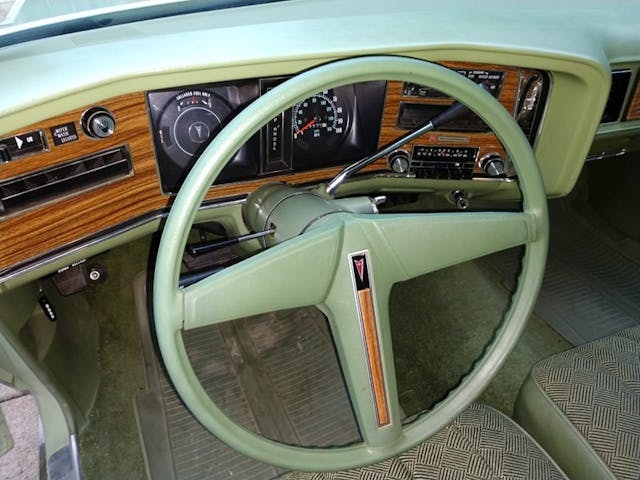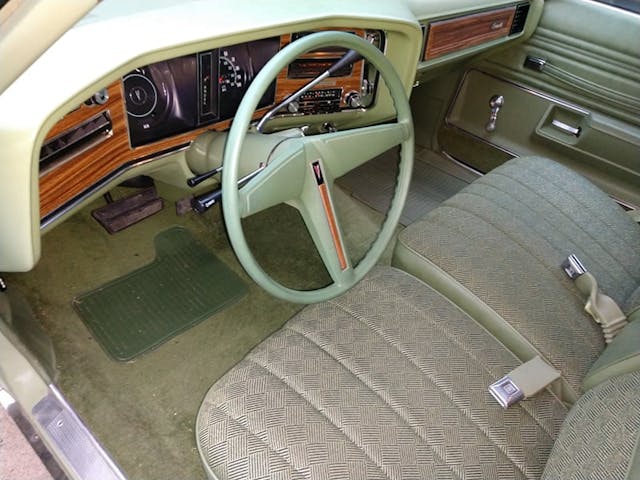1975 Pontiac Bonneville: Holy Guacamole!

The mid-’70s were a great time to be alive if you loved giant, American, V-8-powered, rear-wheel-drive cars. GM alone had a wide variety of B- and C-body coupes, sedans, and wagons to tempt you, from plain-Jane pillared Bel Air sedans to majestic Fleetwood Talismans. Somewhere in between fell the Pontiac Bonneville.

I learned about Bonnevilles from an early age, as my father had a 1979 sedan when I came onto the scene. I remember riding in it. So I always liked them, and as I got older and my knowledge of cars widened, I noticed the earlier ones too. The 1971 full size Pontiacs were all new and a bit more formal looking than their 1969–70 forebears. Available models were Catalina, Catalina Brougham, Bonneville, and the all-new Grand Ville, which displaced the Bonnie from its top-dog spot for the first time since 1957.

These would be the biggest Pontiacs made, and they lasted until 1976. Body styles were diverse, with coupes, sedans, hardtop sedans, a convertible, and six- and nine-passenger station wagons available. Between 1972 and ’74 only minor changes were made, mostly to the nose and tail, and mostly due to ever expanding safety requirements, with massive 5-mph bumpers added along the way.

In 1975 the big Pontiacs would get a more elaborate facelift, with coupes losing their pillarless hardtop roof and gaining a large, fixed rear quarter window instead. Four door hardtops gained an opera window inset into the sail panel, and both the Bonneville and Grand Ville received a very Cadillac-like nose, with quad rectangular headlamps added.

The ’75s also got the federally mandated catalytic converter, now requiring unleaded fuel only. Pontiacs also gained a new high-efficiency ignition and RTS, Radial Tuned Suspension. As the brochure explained, “RTS includes steel-belted radial tires, firm shocks, jounce restrictors, computer-selected springs, and front and rear stabilizer bars.”

The ’75s first appeared at Pontiac dealers on September 27, 1974. Unlike today’s usual roster of crossover, crossover, crossover, truck, maybe one sedan, and another crossover, the line was very diverse, with Catalinas, Bonnevilles, Grand Villes, Firebird Esprits (approved by Jim Rockford, of course), compact Venturas, midsize LeManses, personal-lux Grand Prixs, and the new Astre, a very lightly altered Vega.

And colors! Unlike the tepid selection offered these days, there were actual, bright colors. Orange, lime green! Reds, blues, golds, and browns! For 1975, one of the more unusual colors was Lakemist Green. It’s, ahem, somewhat polarizing. Hospital green? Pea soup green? Perhaps an even more unflattering term? I personally think of guacamole when I see it. Usually when I’m hungry.

My friend Jim Smith, who as a teenager worked as a lot/prep boy at one of the larger Chevrolet dealers in Chicago in the mid-’70s, told me that this color (which was offered throughout the GM range—except Cadillac, I believe—in 1975) was “sales poison.” No one wanted that color, and the dealer had to heavily discount the Monte Carlos, Caprices, and Malibus they had in this hue.

Standard equipment on Bonnevilles included a 400-cubic-inch V-8 with two-barrel carburetor, power steering, power front disc/rear drum brakes, and Turbo Hydra-Matic automatic transmission. Four-barrel 400 and four-barrel 455 V-8s were optional. Ryan’s has the 400.

Our featured ’75 Bonneville could be considered the “Guacamole Luxury Group” as paint, Cordova vinyl roof and interior all are color-coordinated. At the time this car was owned by my friend Ryan Travis, who also had a ’75 Impala in the same color, as can be seen in a couple of the photos he provided.

This car was literally a little old lady’s car. It had only a couple minor bumps and bruises on the exterior from hitting the side of the garage a few times late in her ownership. Otherwise, as you can see, it is in remarkable shape. Original paint, top, upholstery, and pretty much everything.

It looks especially good with the optional Rally II wheels, which gave these Nimitz-class Pontiacs just a dash of sportiness. This car is one of 12,641 1975 Bonneville four-door hardtops built. Base price was $5153 ($25,784 today) and curb weight was an unsurprising 4503 pounds. The other three Bonneville models were the two-door coupe and six- and nine-passenger station wagons. The nine-passenger Bonneville Safari was the most expensive of the quartet, at $5580 ($27,920).

Ryan sold it a while back, at the time it only had 27,770 miles on the odometer. In fact, he sold it back to the fellow he bought it from, who got a bad case of seller’s remorse. I love these 1975–76 Bonnevilles and Grand Villes; they look so luxurious with their Cadillac-like nose, fender skirts, and ample chrome trim. The long, low look is helped by the standard fender skirts, not to mention the 226-inch overall length. Please note that a 2021 Chevy Suburban is 225.7 inches long.


